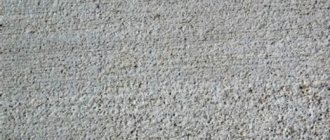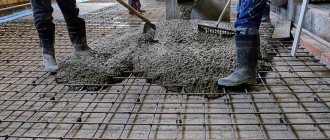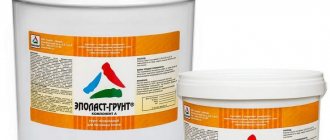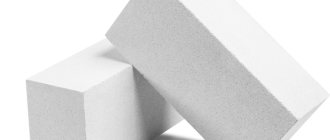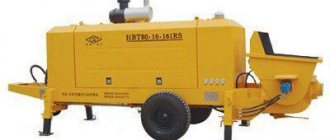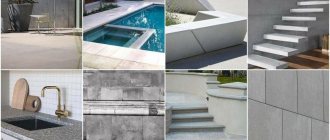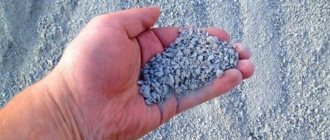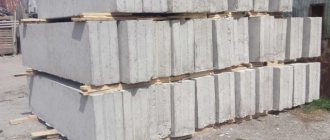The water resistance of concrete is one of the main qualities of a building material. It has no voids in its structure and is dense. The seams between the sections are filled with a waterproofing substance. Concrete has specific characteristics, has a number of advantages and is widely used. Waterproof concrete is used only in monolithic structures (for foundations), because prefabricated buildings have many seams, which makes it impossible to achieve moisture impermeability.
Waterproof concrete is designated by the letter W, even numbers from two to twenty. They mean the level of pressure (measured in MPa x 10 -1 degrees), at which waterproof concrete can withstand water pressure and prevent the passage of moisture.
What affects the waterproof rating?
The water resistance of concrete is a specific characteristic that a concrete solution has. It is influenced by a large number of factors, including:
- the age of the concrete itself. The older it is, the better it is protected from the damaging effects of moisture;
- environmental influences;
- use of additive. For example, aluminum sulfate increases the density of concrete. Builders achieve this using vibration, press action, and vacuum removal of moisture.
As concrete hardens, pores may form. Reasons for this:
- insufficient mixture density;
- presence of excess water;
- reduction in the volume of building materials during shrinkage.
Shrinkage should be minimal for this type of concrete mixture. To avoid problems, follow these steps:
- moistening fresh concrete every three hours for the first three days;
- cover the concrete-filled area with damp burlap or film;
- do not forget about a special product that forms a film.
Before you start working with this type of building material, you need to familiarize yourself with its inherent characteristics.
Return to contents
WATER FOR CONCRETE
WATER FOR CONCRETE To prepare concrete, water is necessary, which takes part in the process of setting and hardening. When setting and hardening, it is necessary to keep the mixture moist so that it does not “burn out” and achieve the design strength. To prepare concrete industrially, tap water is used, which our laboratory constantly monitors for the content of sulfur dioxide, which reacts chemically with cement and renders the final product unusable. The quality of water for concrete and mortars is regulated by special GOST 23732-2011 “Water for concrete and mortars. Technical conditions". The document establishes restrictions on the presence of minerals and chemical compounds in the environment. There is a lot of water in concrete - from 155 liters per 1 m3, depending on the fraction of crushed stone, sand, and the expected brand of stone. The liquid interacts with every grain of sand and dust of cement, so its quality affects the entire volume of the future structure. What determines the water consumption in concrete: Sand and crushed stone fraction; Brand of cement and its type; Expected grade of concrete. The volume of water in concrete should not exceed the norm - in pursuit of plasticity, you can easily lose quality, excess liquid inhibits the hydration of cement, and concrete will not gain the expected strength. Accordingly, you cannot add it in excess of the norm when kneading. If the water content of the concrete solution is too low, it will not allow the components to be mixed properly, and its plasticity will be minimal. To obtain concrete with good plasticity and workability, you need to use special plasticizers! Sugars and phenols delay the hardening of concrete and greatly impair its quality. The normalized content of these substances is 10 ml/liter; Petroleum products form a waterproof film on binder particles; Surfactants (soap residue) also coat the components. Unlike improvers, they only slow down hardening; Soluble salts of sulfate ions and chlorine ions crystallize in the pores of concrete, leading to corrosion of stone and reinforcement. For this reason, using sea water is strictly prohibited. Sewage, swamp and river waters can be used for mixing concrete and cement, but only after cleaning and inspection by the sanitary-epidemiological station. The influence of water on the grade of concrete cannot be underestimated - liquid can both contribute to the acquisition of strength and other design parameters, and significantly reduce them due to the presence of such components in the composition: Water with minerals in excess or insufficient quantities can reduce the hardening rate, final strength, and impede the formation of molecular bonds in the structure of the stone. Organic contaminants (silt, moldy fungi) harm concrete actually and in the future: they prevent mineral components from reacting and crystallizing qualitatively; over time, in a humid environment, organic matter develops and destroys the product throughout its entire volume. Accordingly, you can only use water that meets state standards, that is, from water supply systems, but tested in a laboratory: unfortunately, really good liquid rarely reaches the consumer due to the poor condition of the wire lines. The same applies to washing fillers and watering young hardening concrete. The following waters are also unsuitable for preparing construction concrete: - terminal water, - medicinal water, - drinking mineral water and others, because they contain various salt impurities. Therefore, when preparing concrete in individual construction, you need to know what kind of water is used in mixing the solution. Various additives can also be used to improve product quality. Thanks to them, the hardening process is accelerated, and frost resistance and water permeability also increase. You must know how to use the additive and add it according to the instructions, otherwise you will get the opposite process - an accelerated process of destruction of concrete products will begin.
WATER IN CONCRETE MIXTURE
Water in a concrete mixture serves two functions: firstly, it participates in the chemical reactions that cause the concrete to set and harden, and secondly, it serves as a lubricant for the mixture of gravel, sand and cement, making it easier to lay. As with any reaction, cement and water are combined in certain proportions, namely, for 1 part by weight of cement, about 0.3 parts by weight of water are required for its hydration. However, concrete with such a low water content would be very dry and difficult to compact. Therefore, for lubrication, i.e., to improve the workability of the concrete mixture, excess water is added to it. Since excess water evaporates during concrete hardening, leaving air pores, it is necessary to strive to ensure that its content in concrete is minimal. If the concrete mixture is not completely compacted during placement, numerous air bubbles may remain in it, increasing the porosity of the concrete. Thus, there are two sources of air voids in concrete: air entrapment during placement and excess water that subsequently evaporates. Air bubbles are easier to remove from wet mixtures than from dry ones; the latter require significant additional work to remove air bubbles when compacting the concrete. It follows that for any given method of concrete compaction there is a certain optimal water content in the mixture at which the total volume of pores formed by trapped air and excess water is minimal. Concrete with the minimum total pore volume is the densest and strongest and therefore usually the most acceptable. From the above, we can conclude that the most dense and durable concrete is obtained with a minimum amount of water, but sufficient to ensure the necessary degree of workability of the concrete mixture to achieve maximum density. The degree of workability should be considered in relation to the method of concrete compaction and the type of structure. This point can be illustrated by comparing rigid concrete, placed in a road surface and compacted using powerful equipment, and more flexible concrete, used in the construction of thin reinforced concrete walls and compacted by hand. If rigid concrete were used in the second case, this would almost inevitably lead to the formation of cavities; the density and strength of the concrete would be significantly lower than in the road surface. The term “water-cement ratio” requires clarification, since so far no definite agreement has been reached in various circles of specialists on this issue. The relationship between the water-cement ratio, the fat content of the mixture, the granulometric composition of the aggregate, the workability and strength of concrete was first studied by Professor Abrams (Abrams, USA). The results of his work made it possible to formulate the so-called Abrams law for the water-cement ratio, which states: “Given concrete materials and test conditions, the amount of mixing water determines the strength of concrete if the concrete mixture has sufficient plasticity for work.” From this law it follows that for fully compacted concrete with high-quality aggregate and given cement, the strength of concrete depends only on the water-cement ratio. Tests by the Construction Research Laboratory on a large number of cubes prepared from different concrete mixtures at different water-cement ratios to determine the strength of concrete at different ages at different water-cement ratios resulted in the creation of a series of curves. The initial shrinkage of a concrete mixture before setting is a consequence of water loss through evaporation, absorption by the formwork or base, leakage and infiltration through the formwork. Therefore, the wetter the concrete mixture, the greater the possible loss of water and, therefore, the greater the shrinkage. Contaminated aggregates or aggregates with a significant excess of sand, which require a high water-cement ratio to obtain satisfactory workability, are especially likely to cause shrinkage cracks. The water-cement ratio also affects the amount of concrete shrinkage when moisture is lost during the hardening process. As the water-cement ratio increases, shrinkage increases. An increase in the water-cement ratio also negatively affects other qualities of concrete: water resistance, resistance to low temperatures and weathering, abrasion resistance, tensile strength, and bending strength. In conclusion, it can be said that in almost all cases the best results will be obtained by concrete having the lowest water-cement ratio sufficient to obtain the required degree of workability to ensure complete compaction without the expense of excessive work.
Characteristics of concrete grades for water resistance
Table for selecting concrete grades based on frost resistance and water resistance.
The market offers a huge selection of building materials. And it is not always possible for an ordinary consumer to determine the brand he needs. Therefore, you should familiarize yourself with the possible labeling and use of these brands of mixtures in practice. There is a table corresponding to the strength class of concrete and its brand.
According to GOST, there are requirements for brands that are necessary to achieve the desired result. The most commonly used grades of concrete are waterproof grades no lower than W6. Every brand has limitations. It is thanks to the brands that you can understand what water pressure the concrete solution can withstand.
Indicators that determine the interaction of concrete with water are identified. This:
- straight (the level of water resistance that corresponds to the brand, and the coefficient of possible filtration);
- indirect (the ratio of water and cement, its absorption in accordance with mass).
In everyday life, attention is often paid to the first indicator - the water resistance of concrete; it is considered indicative. The remaining three components are used less frequently, and then only in the process of producing the mixture or in scientific experiments. Each grade characterizes the degree of interaction of moisture with concrete, which can be either less or more. The main brands are considered to be:
- W4. She has a normal degree of permeability. This means that the absorbed level of moisture is within normal limits, but use for buildings with a good level of waterproofing is not suitable.
- W6. Moisture permeability is reduced. Unlike the previous one, it is of average quality, more moisture-proof, and is used most often in construction work.
- W8. Mixture with low water resistance. Permits moisture in small quantities. The mixture turns out more expensive than the previous one.
Brands that go further down the line become more hydrophobic. The most resistant to moisture is the W20 mixture, but it is rarely used due to its high price. Therefore, W10-W20 is used for the construction of reservoirs, bunkers or hydraulic structures. They have one more, rather positive, quality - frost resistance.
It is important to be able to select the class of concrete and its purpose. So, in order to fill the foundation, it is necessary to make W8, and at the same time make additional waterproofing. You can plaster walls in a room with normal humidity using W8-W14. When the room is cold and damp, it is better to use higher markings, while doing additional treatment with a special primer composition.
When finishing the external walls of a house, it is necessary to use the highest grades to ensure the best level of waterproofing. This is important because there will be constant changes in the environment and dampness should not enter the house.
Return to contents
Hydraulic concrete: features and technical characteristics
High humidity negatively affects the strength and durability of buildings. In this case, concrete structures suffer the most. The problem is solved with the help of hydraulic concrete, which, together with the strengthening of structures, ensures their waterproofing.
What is hydraulic concrete
Hydraulic concrete provides rigidity to structures that are frequently or constantly in contact with water.
Along with waterproofing over a wide temperature range, the solution gives structures resistance to significant static and dynamic loads.
This type of heavy concrete is widely used in both industrial and private construction, regardless of climatic conditions.
Composition and types
The performance characteristics of hydraulic concrete are determined by the ratio of cement and water, vibration compaction, quality of additives and mixture holding time. Several types of cement can serve as the basis for the solution:
- Plasticized or Portland cement . It is used in the construction of buildings in areas with variable water levels and where negative temperatures prevail most of the year.
- Hydrophobic . Designed for structures that are constantly in contact with the aquatic environment.
- Sulfate resistant . For objects exposed to hard water.
- Slag or pozzolanic . Prevents the destruction of structures under the influence of water with an aggressive mineral composition.
Pozzolanic cement is characterized by low water loss and resistance to aggressive environments, however, when used, the solution loses its frost resistance.
In addition to cement, hydraulic concrete contains additives, each of which gives the mixture certain properties.
High-density quartz sand improves waterproofing performance and also increases resistance to physical stress. Thanks to crushed stone and gravel, the solution is not afraid of frost and sudden temperature fluctuations.
Microfillers (fly ash) reduce cement consumption, reduce volumetric deformation and heat generation.
Hydraulic concrete differs in characteristics and features:
- According to the particle structure, it can be cast and fine-grained.
- According to operating conditions, the solution can be periodically washed, above-water, underwater and for waters with variable levels.
- Depending on the class, it is used in pressure or non-pressure structures.
The final location determines the solution for external and internal work.
Areas of use
Hydraulic concrete is used in industrial and private construction. Due to its special properties, the material is in demand for the construction of buildings on acidic soils and in areas where the groundwater level reaches a high level.
Hydroconcrete is used in the construction of:
- dams;
- ports, embankments and adjacent areas;
- sewer communications;
- bank vaults;
- overpasses, etc.
Using a waterproof solution, decorative ponds, fountains, and swimming pools are installed.
Hydroconcrete is also used in the construction of bridge structures. The construction of enterprises and facilities in the chemical industry, where high resistance of structures to aggressive environments is required, cannot be done without it.
When choosing hydraulic concrete for the construction of a specific object, the following characteristics specified in GOST 4795-53 are taken into account:
- strength;
- waterproof;
- frost resistance;
- heat generation;
- mobility.
The mixture is subject to high regulatory requirements, which affect the grade of cement, additives and fillers. The rigor is justified by the use of material for the construction of strategic sites.
According to GOST, hydraulic concrete must:
- maintain mobility during the mixing and laying process;
- create a monolithic mass, eliminate cracking and not delaminate during hardening;
- produced with careful observance of the proportions of the constituent components;
- correspond to the time indicators of transition to the solid state.
Hydroconcrete belongs to the category of rigid concrete, which is characterized by a quick, effective result, but a difficult installation process.
Testing and marking
Before being placed at the disposal of builders, hydraulic concrete is subjected to tests, based on the results of which the product is labeled accordingly.
To determine the strength, the material is tested for compression, axial tension and bending, which is achieved using measuring stands. In the process, the solution is observed to be resistant to cracking. In terms of compressive strength, hydraulic concrete is marked B10-B40. Axial tension is indicated by the indices Bt 0.4 - Bt 4, and the bending strength indicator is marked with the letters Btb.
Frost resistance testing is carried out by placing the material in a special chamber, where it is subjected to repeated freezing and thawing for 28 days. Based on the number of cycles during which the hydraulic concrete has not undergone significant changes in properties, marking is made, expressed by codes F50, F100, F200, F300, F400.
To determine water resistance, hydraulic concrete is immersed in an aqueous environment containing various mineral compositions. For 180 days, hydrostatic pressure is applied to it. The indicator is determined by a section of the material that has passed the test. Marking W2—W12 informs about the water resistance of concrete at a corresponding pressure from 0.2 to 1.2 MPa.
Hydraulic concrete used in above-water massive structures is marked BNM. The BHT solution is intended for areas with variable water levels. BPT is used in underwater work.
Main pros and cons
The main advantage of hydraulic concrete is its high water resistance. It differs from other types of mortars:
- increased strength;
- immunity to sudden changes in temperature conditions;
- frost resistance;
- low tendency to crack formation;
- low heat emission;
- possibility of underwater construction work.
The main disadvantages of the material include its expensive price. Quick setting makes it easier to work with the solution in conditions of high humidity, but makes it much more difficult to transport, which is done using special equipment, or the mixture is prepared next to the object under construction.
How to make hydraulic concrete yourself
The production process of hydraulic concrete is similar to the production of standard cement mortars. However, it requires more ingredients and precision in their ratio. In any case, preparing it yourself will be cheaper than purchasing a ready-made mixture.
The cost of homemade hydraulic concrete is reduced by specifying the task at hand. Increased water resistance is necessary when pouring:
- foundation slab;
- floors, basement walls, cellar and garage spaces;
- cesspool;
- decorative pond, swimming pool, water communications.
Frost-resistant and moisture-resistant mixture is advisable for the construction of:
- paths, blind areas;
- walls in contact with blind areas;
- fences, borders and fences;
- street decorative elements;
- load-bearing structures.
The basis of moisture-proof concrete with frost resistance effect is Dehydrol Lux grade 10-2. A solution designed for low temperatures is obtained by using Betonoprava luxury grade 2. For 1 m³ of hydraulic concrete, 4 liters of additive are taken.
When mixing 100 liters of concrete, the following proportions are observed:
- Liquid additive - 0.4 l;
- Cement - 50 kg;
- Sand - 60 kg;
- Crushed stone - 110 kg;
- Water - up to 20 l.
The plasticity of the solution is determined experimentally. The concrete mixer is filled with water, then the liquid additive is poured into it. After this, cement, sand and crushed stone are gradually added. The preparation of hydraulic concrete is completed with five minutes of mixing.
To obtain a high-quality solution that is not inferior in parameters to industrial ones, you must adhere to some rules:
- The ratio of water and cement should not exceed 4:10. The less water, the better the waterproofing.
- 1 m³ of solution must contain at least 350 kg of cement.
- The concrete mixture excludes the presence of clay, loam and other clay aggregates.
- The thickness of the concrete screed must exceed the size of the crushed stone by at least 3 times.
Heat generation, and consequently the shrinkage of the solution, is reduced by adding crushed ice and cooled filler during the mixing process.
After pouring, the hydraulic concrete is thoroughly compacted, which avoids voids.
A monolithic hydroconcrete structure is 100% moisture-proof, which is impossible to achieve in prefabricated structures.
Popular
Source: https://dvabrevna.ru/stroitelstvo/gidrotehnicheskiy-beton.html
Proportions for concrete mixture
To make the desired concrete mixture, it is necessary to strictly adhere to the proportions, because deviation to the side will worsen the properties. This will prevent unnecessary translation of material. You can prepare it either with your own hands or using a special mixer.
The main focus is on the proportion between water and cement. The cement must be taken fresh, marked M300-M400, less often M200 (b15). Class B15 is a good average option. Before use, it is imperative to sift B15 through a sieve. The hydrophobic effect can be achieved by varying the amount of sand and gravel. So, there should be 2 times less sand than gravel.
Possible proportions of gravel, cement, sand are as follows: 4:1:1, 3:1:2, 5:1:2.5. The mass of water should be somewhere around 0.5-0.7. Thanks to these proportions, the mixture hardens well. Various additives are also used to achieve waterproofness.
Return to contents
Hydraulic concrete - what is it?
Building materials for structures that are constantly in contact with water must be highly durable and moisture resistant. Hydraulic concrete has suitable qualities and can withstand the destructive effects of water. Its parameters and composition are determined by the relationship between the level and pressure of water, the size of the building and temperature conditions.
Table of contents:
The following types of hydraulic material are distinguished:
- surface – used for the part that is above the water level;
- underwater - for an area under water;
- concrete in an area where the water level is constantly changing.
Hydraulic concrete can also be massive or non-massive, for pressure and non-pressure structures. Separate requirements for each type are specified in GOST 26633–2012.
Specifications
The main properties of the material include:
- frost resistance;
- high level of water resistance;
- compressive, bending and tensile strength.
According to the degree of frost resistance, hydraulic concrete is divided into 5 grades: F50, F100, F150, F200, F300, where the digital value indicates the number of cycles of freezing and thawing of the material before it loses 25% of its strength. The test is carried out in special freezers. The value of this parameter must be taken into account when constructing buildings that will be exposed to low temperatures. In some cases, frost-resistant concrete of the F400 grade is produced for hydraulic structures; during its production, special impurities are added to the composition in certain proportions.
When the material reaches the age of 180 days, the level of water resistance is determined. During testing, hydraulic concrete must not allow moisture to pass through. Brands W2, W4, W6, W8 have these properties. This means that it can withstand water pressure of 0.2, 0.4, 0.6, 0.8 MPa, respectively. By adding special plasticizer admixtures or changing the proportions of cement, the density and water resistance can be increased to W12.
1. Compressive strength.
Determined by axial compression of a cube measuring 15x15x15 cm. There are several classes, which are designated by the letter B and a number indicating the number of cycles of exposure. The most popular include B10–B40.
2. Flexural and axial tensile strength.
This indicator is important when cracks are not allowed to form in the structure or the work is determined by the strength of tensile concrete. Main classes: from Bt 0.4 to Bt 4 in increments of 0.2. Flexural strength is indicated by indicators from Btb 0.4 to Btb 8 with the same step. In some cases, additional parameters are taken into account: resistance to abrasion by sediments and water flows, deformability, slight shrinkage, etc.
Composition of hydroconcrete
The properties and characteristics of the structures being built are determined by the components included in the cement base:
1. plasticized – increases resistance to water and frost resistance;
2. Portland cement – used for buildings with variable water levels;
3. hydrophobic – added to underwater parts of structures;
4. pozzolanic or slag – highly resistant to mineral-containing and fresh water;
5. sulfate-resistant – resistant to the aggressive influence of hard water.
The optimal fillers are quartz sands from natural deposits, washed to remove dust particles and clay, with a density of 2 t/m3. If the grain size exceeds 2 mm, the level of water resistance decreases. You can use crushed stone or gravel, but they must have high density, flakiness, water and frost resistance.
Areas of application
Concrete for hydraulic structures is laid in large volumes in a short time, this is due to the peculiarities of its use. To regulate the temperature stresses that arise during heat generation, crushed ice is added to the concrete composition, plasticizing and mineral additives are introduced, and the masonry itself is cooled with cold water pipes. Extensive work is carried out using heavy equipment. The choice of cement for mortar is influenced by construction conditions and the principle of functioning of buildings.
| External zones | Low tricalcium aluminate Portland cement |
| Internal zones and underwater part | Pozzolanic or slag cement |
| Above-water part of the building | Plasticized and hydrophobic cement |
Hydraulic waterproof concrete is used in construction:
- bridges, metro tunnels;
- swimming pools, decorative mini-ponds and water amusement parks;
- sewer mines;
- embankment areas;
- hydraulic engineering and treatment facilities (berths, dams, breakwaters).
Individually, such material is used for arranging a basement or building a foundation in cases where groundwater flows through the area.
Cost of main types
The desired grade of hydraulic concrete is obtained by mixing certain proportions of cement, water, aggregate (crushed stone, sand) and additives. The higher the ratio of the first component in the mixture, the higher the grade. In Russia, the most common are M300 and M400.
It is better to purchase goods from trusted factories that have a good reputation. When purchasing material, you must clarify all the parameters and make a description of the future design. The cost is determined individually for each person depending on the requirements for the construction. The manufacturing company determines not only the basic characteristics, but also additional ones, so that the composition best suits the specific building. Items in price lists are not always suitable for the buyer.
| Brand | Concrete class | Crushed gravel filler | Granite crushed stone filler | Sand filler |
| M300 | B22.5 | 3400 | 3650 | 3150 |
| M350 | B25 | 3430 | 3715 | 3200 |
| M400 | B30 | 3500 | 3850 | 3300 |
The table shows the approximate cost in rubles per cubic meter of hydraulic concrete of popular brands that can be bought in Russia.
stroitel-list.ru
Methods for determining water resistance
To determine the level of waterproof indicator, basic and auxiliary methods are used. The main ones include:
- “wet spot” method (measurement of the maximum pressure during which the sample does not allow water to pass through);
- filtration coefficient (calculation of the coefficient associated with constant pressure and time period of the filtration process).
The auxiliary methods include:
- determination by the type of substance that binds the solution (the content of a waterproof solution of hydrophobic cement, Portland cement);
- by the content of chemical additives (the use of special attachments makes the mixtures more waterproof);
- according to the pore structure of the materials (the number of pores decreases - the indicator increases, increasing the moisture-resistant quality with the help of sand, gravel).
Return to contents
Hydraulic concrete - composition, properties, GOST and technical characteristics and application
The first large hydraulic structures of the USSR (Volkhovstroy, Dneprostroy) glorified the technology of hydraulic concrete. Subsequently, it was used in the construction of hydraulic and drainage facilities and their parts that are constantly or occasionally in water.
Many years of experience in the use of building materials proves that hydraulic concrete structures must demonstrate long-term service and meet the requirements for strength, water resistance, and frost resistance.
Concrete used for the construction of concrete and reinforced concrete structures of hydraulic structures or their individual parts must meet the requirements of GOST 4795-68 .
Kinds.
Specific objects are built from hydraulic concrete: dams, piers, breakwaters, cooling towers, wastewater treatment plants, bridges. It is customary to consider 3 types of hydraulic concrete:
- Underwater, constantly located in the water column;
- Located in an area where the water level changes periodically;
- Located above the water and periodically washed by it.
Another classification divides concrete into non-massive and massive, as well as a material for free-flow or pressure structures.
Based on the scope of application, the requirements for water resistance, water resistance (W), frost resistance (F), compressive strength (B) and tensile strength, limited heat generation during hardening, limited shrinkage, deformability, and resistance to abrasion by sediment and water are known for hydroconcrete.
Durability, waterproof and frost resistance.
The class of concrete depends on the indicators (coefficients) of compressive strength and, conversely, the ability to withstand tension. Thus, the compressive strength of hydraulic concrete is determined at its age of 180 days, acting on a cube with a side of 15 cm. Concrete grades start with B3.5 and end with B80, but the range from B10 to B40 is most widespread in construction.
Axial tensile strength eliminates the appearance of cracks. Standard samples are tested at the age of 180 days. Concrete classes increase from Bt0.8 to Bt3.2.
At 180 days of age, hydroconcrete demonstrates 4 types of water resistance: W8, W6, W4, W2. When subjected to standard tests, the material should not allow water to pass under pressure of 0.8 MPa, 0.6 MPa, 0.4 MPa, 0.2 MPa, respectively. Special additives have been developed to increase water resistance above W12.
Hydraulic concrete works in moderate, severe and especially severe weather (climatic) conditions. Frost-resistant hydraulic concrete is produced in 5 grades: F300, F200, F150, F100, F50. By means of special additives, frost resistance is increased beyond F400.
The grade is determined by the number of freezing and thawing cycles of concrete aged 28 days, during which the strength decreased by no more than 25%. Frost resistance is important for those structures that are exposed to the combined effects of water and subzero temperatures.
Compound. (Technical requirements for materials for the preparation of hydraulic concrete GOST 4797-69)
To prepare a hydroconcrete mixture, it is permissible to use the following types of cements:
- Portland cement;
- Plasticized (allows you to obtain frost-resistant and waterproof concrete while reducing cement consumption by 10%);
- Hydrophobic;
- Pozzolanic slag (has great physical and chemical resistance to fresh and mineralized natural waters);
- sulfate-resistant (for harsh conditions and aggressive waters).
The consumption of cement is designed to ensure the required density of concrete, and it itself is present in massive/non-massive structures in an amount not exceeding 350/400 kg/cub.m. For laying large volumes of mixture in a short time, cement with a low heat of hydration is recommended (less than 50 calories in 3 days; 60 cal / 7 days per 1 gram of cement).
Quartz sands are optimal as fillers for hydraulic concrete. sand is usually increased to increase water resistance. Gravel and crushed stone must be extracted from sedimentary or igneous rocks whose frost and water resistance have been tested and verified.
Microfillers in hydraulic concrete (for example, fly ash) serve to reduce the amount of cement consumed, reduce volumetric deformations and heat generation, while maintaining mobility and density.
In order to enhance resistance to frost and water resistance, special chemical additives such as SDb, or SNv superplasticizers, or organomineral ones are introduced into concrete.
New additives have been developed, for example, TsMID-4Zh for structures in contact with drinking water.
Source: https://www.betonmo26.ru/gidrotekhnicheskij-beton.html
What is added to concrete to make it waterproof?
The principle of action of additives in concrete.
Additives are the main component in a concrete mixture, increasing its waterproofing properties. Concrete becomes moisture resistant and durable. But this mixture should only be used on horizontal surfaces, since on vertical surfaces it simply slides down. Of course, this can be avoided by using a special protective film that presses the solution against the structure. But it will take a lot of time and effort.
The market puts forward a huge number of different additives, with different prices. There are several substances that are most commonly used as additives. This:
- silicate glue;
- ferric chloride;
- calcium nitrate. Perhaps the cheapest option, which has excellent resistance to moisture. It dissolves well in water, is not toxic, however, it can cause a fire;
- sodium oleate and many other additives that increase moisture-resistant quality.
You must add the component following the instructions!
There are discussions about what additives are best added to the concrete mixture: domestic or imported from abroad? A definite answer has not yet been found, since they all have good quality brands. But they still insist that domestic ones are better because they are distinguished by their low price, which means they can be used for mass use.
Return to contents
Hydraulic concrete: GOST, composition, technical characteristics, properties, application
For structures and structures that come into varying degrees of contact with water, a special material is required that can withstand the aggressive effects of a liquid environment. For construction in such conditions, hydraulic concrete is used. It has the necessary characteristics for the safe operation of the constructed facility.
Definition
Hydraulic concrete belongs to the category of heavy concrete; it is used for the construction of embankments, bridges and other structures, parts of the structures of which in some places are either completely immersed in water or have contact with it.
A special feature of the material is its ability to maintain its original characteristics in an aggressive environment without reducing the quality and load-bearing capacity of the element. Some functions, such as strength, increase over time in an air environment, provided that the integrity and structure of the stone is maintained.
Classification
There is a certain set of requirements that hydraulic concrete must meet. GOST 26633-2012 “Heavy and fine-grained concrete. Technical Specifications" regulates the quality of the components that make up the mixture and the properties of the finished solution. The document is international in nature; 8 countries have adopted it.
According to GOST, hydraulic concrete is divided into several groups according to the degree of immersion and exposure to the aquatic environment:
- Surface.
- Underwater.
- For variable water levels.
Based on the volume of the structure being created, the material is divided into:
- Massive - complex shapes and large dimensions of the element, accompanied by uneven hardening with the release of heat.
- Non-massive - simple designs with small dimensions.
As force is applied to the hardened object:
- For pressure systems.
- For non-pressure elements.
An additional classification is used to separate the place where concrete is used:
- For internal structures (they are less susceptible to washout and water pressure, but must withstand static influences).
- For external elements and surfaces (those are influenced by the active movement of water and unstable chemical background).
Mixture composition
The solution must meet the requirements of GOST to obtain a stone of sufficient hardness, strength and safety. All components included in hydraulic concrete undergo quality control. Mixture composition:
- The main component is astringent. For an effect resistant to aggressive water, sulfate-resistant cement is used. For variable immersion levels, use hydrophobic or with the inclusion of plasticizing additives. In other cases, pozzolanic, slag or Portland cement is used.
- Fine aggregate – quartz sand, it increases the resistance of concrete to water. It should not contain small impurities and debris - in wet conditions, inclusions can significantly weaken the material.
- Coarse aggregate – gravel and crushed stone from sedimentary and igneous rocks. This type is highly hydrophobic and frost-resistant. The fraction of stones depends on the technical characteristics of the concrete solution required for use in specific conditions. The shape of the filler should be voluminous and convex; flaky crushed stone or gravel has less strength.
- Additives improve the properties of the solution. They increase the stone’s resistance to temperature changes and aggressive influences of water, reduce heat generation as needed, and prevent the occurrence of cracks.
The properties of all components, their parameters, and the exact formulation of the solution are prescribed in GOST 26633-2012 clause 3. Compliance with the standards must be carried out in any production; the finished mixture receives a document confirming compliance with the standard.
The material has many varieties. They are distinguished by the composition and properties that hydraulic concrete should have. Technical characteristics depend on the brand and type of composition.
The main ones include compressive strength, axial bending, tensile strength, frost resistance and hydrophobicity.
The working solution is selected based on the totality of these indicators, since each batch may have different properties, which is unacceptable for this material.
Strength
The first and most important indicator is the value of compression resistance, since most structures experience a forceful vertical load from the volume of the building located above.
The strength of concrete is determined by creating a test cube and then testing it under presses. The prototype is kept for 28 to 180 days to gain strength. In the case of hydraulic material, the cube is placed in water while it hardens.
Tests are carried out under force until cracks appear.
Based on the results of the study, concrete is assigned a class from B3.5 to B60. The most common types are B10-B40.
Tensile and bending strength
Structures that are not affected by vertical load are subject to other effects - axial tension and bending. To understand whether concrete can withstand such deformations, it is tested in laboratory conditions. Tensile strength grade – Bt0.4…4.0.
Waterproof
Determined in laboratory conditions on sample cubes of the same age as in the first case. The essence of the test is to gradually increase the water pressure until it seeps through the concrete body. Based on the result, the stone is assigned the waterproof grade W2-20.
For aggressive conditions of sea water and high pressure, hydraulic concrete not lower than W4 is used.
Frost resistance
In conditions of high humidity, special attention is paid to temperature changes with the possibility of water freezing.
As you know, when the liquid expands, it crystallizes and causes damage to the building materials into which it managed to penetrate.
To prevent this from happening to a critical structure, special hydraulic additives and plasticizers are added to the solution in production to increase the concrete’s resistance to hardening.
Frost resistance grade F shows how many cycles of complete alternating freezing and thawing a concrete sample can withstand with a loss of strength of no more than 15%. For a hydraulic mixture, tests are carried out on water with its heating and transformation into ice.
Based on the results of the study, hydrophobic concrete is assigned a frost resistance grade of F50-300.
Mixture improvers
Indicators of strength, water resistance and frost resistance are laid down at the stage of mixing the solution at the factory. The special properties of hydraulic concrete are determined by salts of various metals and composite compounds.
Additive modifiers are divided into 2 groups.
Group I reduces water absorption up to 5 times by the design strength gain period of 28 days. Among the most used:
- Phenylethoxysiloxane 113-63 (formerly FES-50).
- Sodium aluminum methyl siliconate AMCP-3 (Russia).
- “PlastIL” (Russia).
- Hydroconcrete (EC).
- Addiment DM 2 (Germany).
- Liga Natriumoleat 90 (Russia).
- Sikagard-702 W-Aquahod (Switzerland).
Group II is less powerful (decrease by 2-4.8 times). Its use is possible for mixing surface concrete:
- Polyhydrosiloxanes 136-157M (formerly GKZh-94M) and 136-41 (formerly GKZh-94).
- “COMD-S”.
- Stavinor Zn E Stavinor Ca PSE.
- HIDROFOB E (Slovenia).
- Cementol E (Slovenia).
- Sikalite (Switzerland).
- Sikagard-700S (Switzerland).
Group III is not used to create hydraulic concrete. Additives reduce water absorption up to 2 times.
Other properties
When choosing a working mixture, not only the main characteristics of hydraulic concrete are taken into account, but also its other parameters:
- Shrinkage amount.
- Resistance to deformation.
- The degree of resistance to water flow and pumping pressure.
There is no single recipe for hydraulic concrete: in each case, the chemical composition of the water, the magnitude of the pressure and other loads are taken into account. In accordance with the requirements, fillers and additives are used that can ensure reliable operation of the future stone.
Making your own concrete mixture
If you are planning to concrete something on your site yourself, then I suggest you consider a few tips. Here is a table of popular brands of concrete with their component compositions:
This table lists the most popular grades of concrete, which are usually used in the construction of private houses. Take the required grade of concrete from your project and calculate the need for volumes of concrete. This calculation is not difficult to make - according to the dimensions from the drawings, select the length, width and depth of the structure and multiply. This will give you the cubic capacity of concrete required.
From the table, determine the total requirement for the weight of all components and purchase them at a hardware store. To help you, approximate weight indicators of volumes of materials:
- cement – 1500 kg/m3;
- sand – 1800 kg/m3;
- crushed stone – 1400 kg/m3.
Based on these values, you can calculate the required proportions in buckets, depending on the displacement of the existing bucket.
Now about water - it needs 1/2 of the mass of cement, as mentioned above. Don't forget that a liter of water weighs 1 kg. It is also necessary to know exactly the volume of the concrete mixer and calculate the number of buckets of all components for one batch.
Preparation of the mixture: first, a small amount of water is poured into a running concrete mixer, then cement, sand, and crushed stone and remaining water are added to a homogeneous mass without lumps. The prepared batch must be used without delay.

